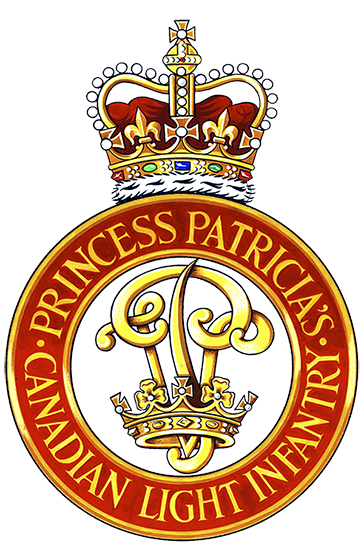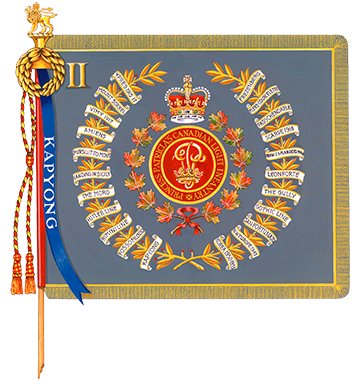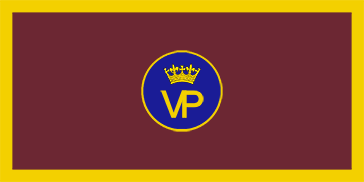Princess Patricia's Canadian Light Infantry
The official lineage of Princess Patricia's Canadian Light Infantry regiment.

Colonel-in-Chief: The Right-Honourable, Adrienne Clarkson CC CMM COM CD
Badge
Description
Argent the coronet of Her Royal Highness Princess Patricia enfiled by her cypher Or all within an annulus Gules edged and inscribed PRINCESS PATRICIA'S CANADIAN LIGHT INFANTRY in letters Or the whole ensigned by the Royal Crown proper.
Symbolism
The crown represents service to the Sovereign. The cypher and coronet are those of H.R.H. Princess Patricia, the granddaughter of Queen Victoria, who granted the regiment the right to bear her name. "PRINCESS PATRICIA'S CANADIAN LIGHT INFANTRY" is the regimental title.
Motto
None
Marches
Quick March
Medley of - "Has Anyone Seen the Colonel", "Tipperary", and "Mademoiselle from Armentières"
Slow March
"Lili Marlene"
Alliance
British Army
The Rifles
Australian Army
The Royal Australian Regiment
Affiliation
Loyal Edmonton Regiment (4th Battalion, Princess Patricia's Canadian Light Infantry)
Regimental colour

Camp flag

Battle honours
The First World War
YPRES, 1915, '17; Frezenberg; Bellewaarde; MOUNT SORREL; SOMME, 1916; Flers-Courcelette; Ancre Heights; ARRAS, 1917, '18; Vimy, 1917; Arleux; HILL 70; Passchendaele; AMIENS; Scarpe, 1918; HINDENBURG LINE; Canal du Nord; PURSUIT TO MONS; FRANCE AND FLANDERS, 1914-18, SIBERIA, 1918-1919.
The Second World War
LANDING IN SICILY; Leonforte; Agira; SICILY, 1943; The Moro; The Gully; LIRI VALLEY; Hitler Line; GOTHIC LINE; RIMINI LINE; San Fortunato; Savio Bridgehead; Naviglio Canal; Fosso Munio; Granarolo; ITALY, 1943-1945; Apeldoorn; NORTH-WEST EUROPE, 1945.
United Nations Operations - Korea
Kapyong; KOREA, 1950-1953.
Honorary Distinction
The United States Presidential Unit Citation battle streamer and shoulder badge for the actions at Kapyong on 24 and 25 April 1951. The distinction of bearing this streamer and badge belongs to the 2nd Battalion alone.
South-West Asia
AFGHANISTAN
Lineage
This Regular Force regiment originated in Ottawa, Ontario on 10 August 1914, when the 'Princess Patricia's Canadian Light Infantry' was authorized to be formed.Footnote 1
Notes:
A Permanent Active Militia component was formed on 1 April 1919 (GO 27/19) and the Canadian Expeditionary Force component of the regiment was disbanded on 30 August 1920 (GO 149/20).
On 1 March 1946, the 'Princess Patricia's Canadian Light Infantry, CASF, CIC' was disbanded (GO 139/46) and the '2nd Battalion, Princess Patricia's Canadian Light Infantry, CIC' was redesignated 'Princess Patricia's Canadian Light Infantry, CIC' (GO 138/46). On 27 June 1946, the Princess Patricia's Canadian Light Infantry was embodied in the post-war Permanent Force (Active Force) (GO 158/46) (see operational history below).
On 7 August 1950, a '2nd Battalion, Princess Patricia's Canadian Light Infantry, RCIC' was authorized to be formed as an Active Force unit embodied in the Special Force (CAO 110-2, Supp Issue No. 210/50). On 1 January 1952, it ceased to be embodied in the Canadian Army Special Force (CAO 76-8, Pt 'B', Supp Issue No. 283/52).
On 9 August 1950, the Princess Patricia's Canadian Light Infantry, RCIC was redesignated 'Princess Patricia's Canadian Light Infantry, (1st Battalion) RCIC' (CAO 76-2, Supp Issue No. 193/50) and on 29 September 1951, it was embodied in the Special Force (CAO 76-8, Pt 'B', Supp Issue No. 260/51). On 9 April 1952, it was redesignated '1st Battalion, Princess Patricia's Canadian Light Infantry, RCIC' (CAO 76-2, Pt 'B', Supp Issue No. 283/52) and on 31 December 1952, it ceased to be embodied in the Canadian Army Special Force (CAO 76-8, Pt 'B', Supp Issue No. 322/53).
On 30 November 1950, a '3rd Battalion, Princess Patricia's Canadian Light Infantry, RCIC' was authorized to be formed as an Active Force unit embodied in the Special Force (CAO 110-2, Supp Issue No. 208/50). On 1 November 1953, it ceased to be embodied in the Canadian Army Special Force (CAO 76-8, Pt 'B', Supp Issue No. 365/53) and on 8 January 1954, it was reduced to nil strength (SD 1 Letter No. 53/139, 8 December 1953). The battalion was disbanded on 21 July 1954 (CAO 78-2, Pt 'B', Supp Issue No. 401/54).
On 27 April 1970, a '3rd Battalion, Princess Patricia's Canadian Light Infantry' was authorized to be formed as a Regular Force unit (CANFORCEHED Message 1160-110/076 (DO) (DHH 73/1223, series 2, file 1050)
On 12 August 1977, all generic titles in the Canadian Forces, such as 'battalion', were made bilingual (Memorandum, DGBB (Director General Bilingualism and Biculturalism), 1901-1/1211-7-4, 12 Aug 77).
On 3 November 1997, the regiment was granted the perpetuation of the '260th Battalion (Canadian Rifles), CEF (Siberia)' (NDHQ Memorandum 1065-1 (DHH), 30 October 1997).
'The Loyal Edmonton Regiment (4th Battalion, Princess Patricia's Canadian Light Infantry)' is a separate and distinct regiment.
Perpetuations
'260th Battalion Canadian Rifles, CEF (Siberia)'
Headquarters Location
1st Battalion: Edmonton, Alberta
2nd Battalion: Shilo, Manitoba
3rd Battalion: Edmonton, Alberta
Operational history
The First World War
The regiment embarked for Great Britain on 27 September 1914.Footnote 2 It landed in France with the 80th Brigade, 27th Division of the British Expeditionary Force on 21 December 1914,Footnote 3 and on 25 November 1915 it joined the Canadian Corps as part of the 7th Infantry Brigade, 3rd Canadian Division, with which it fought in France and Flanders until the end of the war.Footnote 4 The overseas component of the regiment was disbanded on 30 August 1920.Footnote 5
The 260th Battalion, which was authorized on 1 November 1918 as the '260th Battalion, Canadian Rifles, CEF (Siberia)',Footnote 6 embarked for Russia on 29 December 1918.Footnote 7 It served with the 16th Infantry Brigade as part of the Allied Forces in eastern Russia until 9 May 1919.Footnote 8 The battalion was disbanded on 15 November 1920.Footnote 9
The Second World War
The regiment, which was placed on active service on 1 September 1939, under the designation 'The Princess Patricia's Canadian Light Infantry, CASF',Footnote 10 embarked for Great Britain on 21 December 1939.Footnote 11 It landed in Sicily on 10 July 1943 and in Italy on 4 September 1943 as part of the 2nd Infantry Brigade, 1st Canadian Infantry Division.Footnote 12 On 12 and 13 March 1945 the regiment moved with the 1st Canadian Corps to North West Europe, where it fought until the end of the war.Footnote 13 The overseas regiment was disbanded on 1 March 1946.Footnote 14
On 1 June 1945, a second Active Force component of the regiment was mobilized for service in the Pacific theatre of operations, under the designation '1st Canadian Infantry Battalion (Princess Patricia's Canadian Light Infantry), CASF'.Footnote 15 It was redesignated: '2nd Battalion Princess Patricia's Canadian Light Infantry, CIC' on 2 September 1945;Footnote 16 and 'Princess Patricia's Canadian Light Infantry, CIC' on 1 March 1946.Footnote 17 On 27 June 1946, it was embodied in the Permanent Force as the 'Princess Patricia's Canadian Light Infantry'.Footnote 18
United Nations Operations - Korea
Three battalions of the regiment served in Korea as part of the 25th Canadian Infantry Brigade Group, 1st Commonwealth Division. The 2nd Battalion, initially part of the 27th British Commonwealth Brigade until 25 April 1951 then the 28th British Commonwealth Infantry Brigade until 27 May 1951, was the first to arrive in Korea (18 December 1950 to 4 November 1951), followed by the 1st Battalion (29 October 1951 to 4 November 1952) then the 3rd Battalion (29 October 1952 to the end of the conflict).Footnote 19
South-West Asia
Several Companies and Platoons of the Princess Patricia’s Canadian Light Infantry served in Afghanistan from 2002 to 2014.Footnote 20